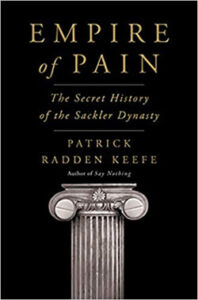

“Empire of Pain” recounts how another code of silence did its work, obscuring complicity and deflecting guilt. Keefe is a staff writer for The New Yorker whose previous book, “Say Nothing,” depicted the code of silence that clung to the Troubles in Northern Ireland. What starts out as a humble origin story in 1913 - the year of Arthur Sackler’s birth in Brooklyn, to immigrants from Central Europe - becomes an engrossing (and frequently enraging) tale of striving, secrecy and self-delusion. Many books about the opioid crisis have been published in recent years, including Beth Macy’s “Dopesick” and Sam Quinones’s “Dreamland.” Back in 2003, the New York Times reporter Barry Meier released “Pain Killer,” a meticulous indictment of Purdue Pharma that compared the narcotic power of Ox圜ontin to a “nuclear weapon.” In “Empire of Pain,” Keefe sets out to do something different, tracing the fortunes of the family dynasty at the center of it all. “After the introduction of Ox圜ontin, it did.” “Prior to the introduction of Ox圜ontin, America did not have an opioid crisis,” Keefe writes. In “Empire of Pain,” Patrick Radden Keefe tells the story of how the Sackler family became a decisive force in a national tragedy. Since 1996, 450,000 Americans have died from opioid overdoses, making them the leading cause of accidental death in the country. But even the most elaborately complex phenomena can still have relatively simple beginnings, a kernel that requires only the ingenuity and ruthlessness of people who are ready to exploit it. Taking cover under complexity has been a common strategy for tobacco companies and big oil - entities that have profited from disaster while seeking ways to avoid any moral opprobrium and expensive accountability. “I don’t believe Purdue has a legal responsibility,” one family member insisted in a deposition two years ago, when asked about the company’s role in the opioid crisis. What’s in a name? Apparently plenty for the members of the Sackler family, who plastered their surname on prestigious galleries and institutions while taking care to keep the source of their riches under wraps.įor years, their company Purdue Pharma had been in the news for creating Ox圜ontin - the powerful painkiller whose introduction in 1996 ushered in a new era of both pain management and opioid addiction - while the Sackler name remained better known for philanthropy than for pharmaceuticals. To hear more audio stories from publishers like The New York Times, download Audm for iPhone or Android.


 0 kommentar(er)
0 kommentar(er)
